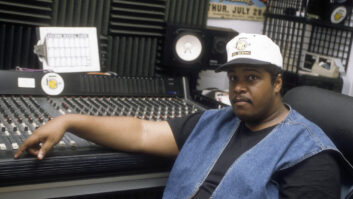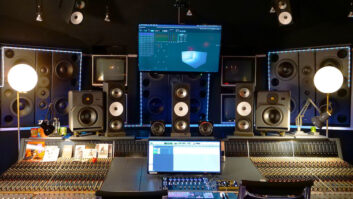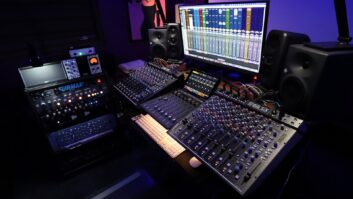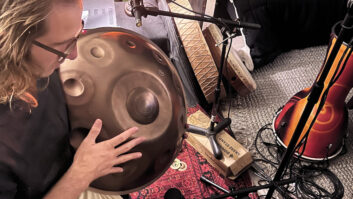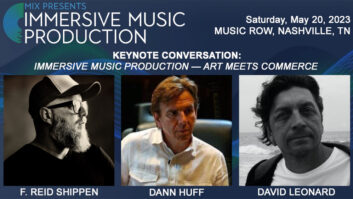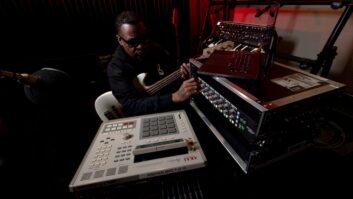For the majority of his career, David Lowery has lived somewhere just outside the norm. Whether it was his early days as a member of the eclectic rock outfit Camper Van Beethoven, or as the voice of a disenfranchised generation in Cracker, Lowery has touched all sides of the fringe. And much like his frontman career, his production credits run the aural gamut-including FSK, Lauren Hoffman, Sparklehorse and the Counting Crows’ latest.
Though he names the Vivadixiesubmarinetransmissionplot album from Sparklehorse as his first real production gig, which he recorded under the pseudonym David Charles, it was the early recording days that sowed the production seeds Lowery has reaped recently. “It was a good 12 or 13 years ago, and the Cat Heads were going to make a record,” he recalls. “They said, ‘Hey, why don’t you produce our record?’ I was like, ‘Well, I don’t really know how to do that.'” They pointed out he had made a few albums, so he gave it a shot. “I did that and learned a little bit. I wouldn’t say I was a producer really, yet, but I realized that was something I liked to do.”
To be sure, the experience of sitting on the other side of the glass changed the way he looked at his own songwriting. He admits it’s difficult to uncover a song’s weak points without being able to watch musicians perform. “If you couldn’t look at people, if you just listened to the song recorded, it obscures the flaws. I was always interested in that,” he says. “Like, finding the flaw and then figuring out how I can make the song better. I guess that was the original impetus of being producer.”
So, after the Cat Heads experience, he paid more attention when Camper was in the studio. That newfound knowledge led him to work with a handful of obscure and cult bands and artists at first.
Of the Sparklehorse sessions, Lowery reports, “Mark Linkous is a guy I just thought was really talented, and he just had this sort of weird vision of the world. Over a period of four or five years, I figured out how to record his songs within that vision using whatever we could, whether it was a 4-track or my 8-track cassette player or using little microcassettes. We sort of made a soundscape.” By creating that soundscape, he says, people started to regard him more as a producer. “I guess because the production has such a strong part of the sound in that record,” he says.
Shortly after the Sparklehorse record was released, he “accidentally” bought a studio in Richmond, Va., with fellow Cracker Johnny Hickman and engineer John Morand. Rather than making Sound of Music Studios a technology showcase, Lowery concentrated on making it a comfortable spot to work. “You go to record in a place that makes you creative, you know?” he asks. That said, they’ve stocked the studio with a range of preamps (from Neve to API to Altecs) and an assortment of interesting audio tools like Distressors and an amp simulator called the Pod. “It’s like the Rockman of the ’90s,” he gushes. “It’s red, and it looks like it was designed by the same guy who designed the ’87 Ford Taurus. It’s just a weird little thing, and what’s really great about it is that you just insert it on some line channel and then turn through all the different amps until something sounds like you want it to.” Lowery says he’s run everything through the effect, including drums, vocals and guitars, and then he’ll often compress the signal to manipulate it even further. On the microphone front, Lowery’s current favorite is a Soundelux U95S, a multipattern tube mic, which he uses on vocals and guitars and for room tones.
As for Lowery’s production style, he says he’s a mix of Dennis Herring and Don Smith, two producers he worked with while recording Cracker albums. “Dennis comes from a real arranged point of view; Don Smith is kind of the exact opposite,” Lowery explains. “Don is all about the vibe-don’t fix anything, just capture moments. I’d sort of have to twist his arm to fix something. ‘Hey, man, I played a wrong chord here; could I fix that?’ ‘No, man, nobody will notice.’ I like that because it’s two extremes, but I’m probably even different than both of them.”
And sometimes he varies his approach from project to project. “I like to produce two ways: Sometimes I like to twiddle the knobs, and sometimes I just don’t want to know anything about what happens with recording; I just want to work on the songs,” he explains. “Lately I’m on this trip of playing bass. I’m working with Kristin Asbury, who sings backup vocals on the last Cracker record, on some songs, and I’m doing it playing bass.” He pauses for a second and then adds, “I don’t think I have any methods, and I enjoy not having any methodology, I guess.”
Yet, one of the first things he tries to do is get a band on a schedule. It’s his way of avoiding those unproductive studio afternoons. “I’m serious, there is this dead time from about 4 o’clock to about 5 o’clock,” he says. “I don’t think there has ever been a note played on any record that stayed, that actually made the final mix on any record, that was recorded between 4 and 5 in the afternoon. That’s when the phone rings, and everybody’s too wired on coffee, and there’s no drinking yet. So it’s like that transition time between coffee and beer. Nothing good happens in that time period.”
Work on the Counting Crows’ latest, This Desert Life, was pushed much further into the evening. “I doubt anything remained on the record that wasn’t recorded after 10 o’clock at night,” he recalls. “Some of the best stuff was done at 2 in the morning.”
The Counting Crows sessions, which took place in a house in the Los Angeles hills (as had their two previous studio albums), taught Lowery a lesson about mixing and matching takes. He points to the catchy, radio-friendly song “Mrs. Potter’s Lullaby,” which contains vocal and guitar takes from sessions months apart. Lowery believes that it works because they didn’t obsess on the minor tempo and performance differences. “I don’t get into all the tiny little details. I hate it when the song is dependent on that,” he says. “If you’re worried about the bass being a little bit out here, and a little bit out there, that’s not going to make the song great. Lots of people get lost in that, like you’re worried about these little details, and the problem is that there’s some bigger flaw in the song.”
Looking back on his varied production credits, Lowery notes he’s interested in fairly specific types of bands. “When I come to produce something it’s got to be very eclectic,” he says. “It’s got to be something with a story, that’s told well, and also played with some kind of conviction and some kind of emotion that I believe. So that leads me into a lot of different areas. I would have a hard time recording the coolest band in the world if I just thought that they were making a bullshit record. I think I would get fired, because I would probably be quite unhappy.”
And whether it’s a Platinum mainstay like the Counting Crows, a cult favorite like Sparklehorse, or even an unknown band like The Seymores, Lowery says the most frustrating thing for him is when an artist won’t push the envelope. “The only thing that ever bugs me about producing a record, and it happens quite a bit even with the most underground bands, is that I find I want to take more chances than the artist does,” he explains. “Somehow I end up where the artist is saying, ‘I don’t know-that’s kind of a weird note.’ And I’ll explain, ‘It’s a passing note, it sounds beautiful and then it changes key in the next verse.’ I’ll have all kinds of explanations, but sometimes the artist thinks it’s too weird. It doesn’t matter who it is or whatever kind of music they’re playing; that’s the role I like to be in. If I’m not in that role, I feel like I’m not working on the right project.
“I just have to feel like there’s a real strong artistic vision with the artist, and if there is, then it’s fun to make a record,” he says. “If there isn’t, it’s like assembling furniture or something.”

